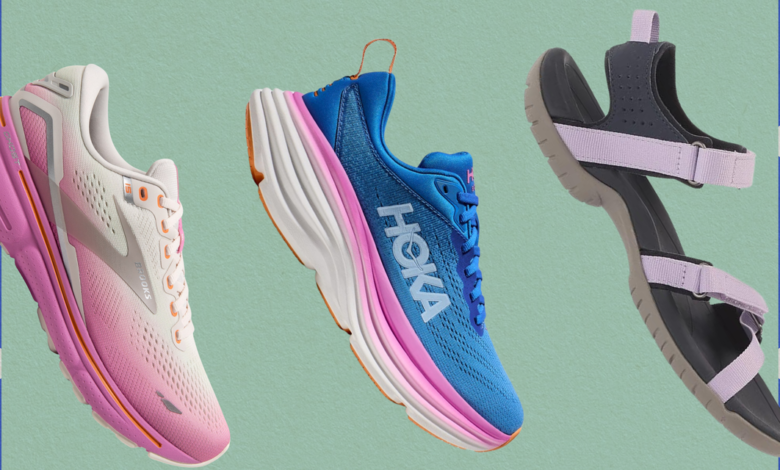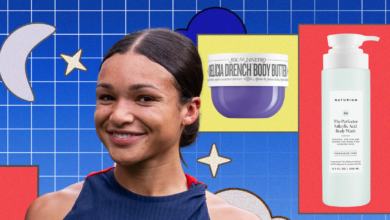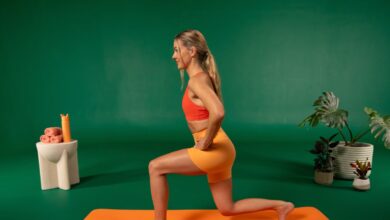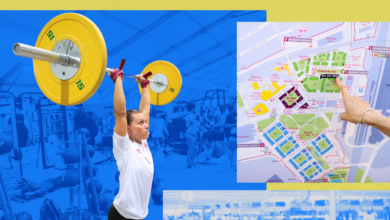The Best Shoes for Plantar Fasciitis, According to Experts

All products featured on SELF are independently selected by our editors. However, when you buy something through our retail links, we may earn an affiliate commission.
It only takes one especially uncomfortable flare up of heel and arch pain to realize the importance of proper footwear. Thankfully, the best shoes for plantar fasciitis can relieve the tension in your feet and help you avoid these frustrating days in the first place. We spoke with physical therapists and podiatrists to find the right shoes for anyone who deals with this condition.
Our top picks:
- Best Walking Shoes: Kuru Quantum
- Best Running Shoes: Hoka Bondi 8
- Best Hiking Boots: Hoka Kaha 2 Gore-Tex
- Best Sandals: Teva Verra Sandal
- Best Dress Shoes: Clarks Sharon Dolly Loafer
- Best Slippers: Vionic Gemma Mule Slipper
- Best Insoles: Powerstep Pinnacle Insoles
Jump to:
- Best Shoes for Plantar Fasciitis
- Best Walking Shoes for Plantar Fasciitis
- Best Running Shoes for Plantar Fasciitis
- Best Hiking Boots for Plantar Fasciitis
- Best Sandals for Plantar Fasciitis
- Best Dress Shoes for Plantar Fasciitis
- Best Slippers for Plantar Fasciitis
- Best Insoles for Plantar Fasciitis
- More Footwear to Consider
- What is Plantar Fasciitis?
- What Causes Plantar Fasciitis?
- How to Choose the Best Shoes for Plantar Fasciitis
- What to Avoid When Buying Shoes for Plantar Fasciitis
The best shoes for plantar fasciitis
Below, you’ll find expert-approved shoes (including sneakers, dress shoes, sandals, and slippers), with plantar fasciitis friendly features—like extra padding, sturdy arch support, and securely-fitting footbeds—along with top suggestions for removable insoles to make any pair more comfortable. But don’t worry, we’re not talking stereotypical, clunky orthopedic footwear (although, those certainly do the trick). Instead, we’ve rounded up some seriously stylish options worth trying that come highly recommended by experts.
Hoka shoes have deep heel counters (the part of the shoe that surrounds the back of your foot) and cloudlike cushioning, which feel like a glorious hug. That snug, plush fit makes them some of the best walking shoes for people with plantar fasciitis. Carla Gamez, DPM, a podiatrist at Illinois Bone & Joint Institute (IBJI), recommends the Clifton because of its responsive midsole, which, despite its higher amount of cushion, helps propel you forward as you walk. The latest version, the Clifton 9, helped alleviate SELF’s executive editor’s plantar fasciitis pain and secured its place as her go-to sneaker.
- Sizes available: US 5 to 12 | Widths available: regular and wide | Heel-to-toe drop: 5 millimeters | Materials: mesh, polyester, EVA foam, and rubber | Colors available: 17 options
This comfortable walking shoe from Kuru is designed to help alleviate foot pain, including the discomfort that comes with plantar fasciitis. The brand’s patented Kurusole technology hugs and supports your heels and arch to help them better absorb impact from standing and walking, Bianca Beldini, DPT, a physical therapist, founder of Sundala Wellness, and a USA Triathlon Level One coach in New York City, tells SELF.
- Sizes available: US 5 to 12 | Widths available: medium and wide | Heel-to-toe drop: 8 millimeters | Materials: mesh, synthetic fabric, and rubber | Colors available: 10 options
Vionic
Walk Strider Walking Shoes
With a sturdy design and a high level of arch support, Vionic’s Walk Strider can help alleviate the stabbing pain of plantar fasciitis, Gigee Bhular, DPM, a foot and ankle physician at Virtua Health in New Jersey, tells SELF. While its rigid midfoot helps prevent rolling, its flexible upper bends with your foot when you’re on the move.
- Sizes available: US 5 to 13 | Widths available: medium and wide | Heel-to-toe drop: 16 millimeters | Materials: mesh, leather, nylon, EVA foam, and rubber | Colors available: 2 options
Hoka is known for its “maximalist” shoes (think: chunky with thick soles) that starkly contrast the more minimalist models out there. And all that extra padding makes Hoka one of the best running shoes for people with plantar fasciitis—particularly the Bondi style, which is wide and lightweight yet super cushioned, Dr. Beldini says.
- Sizes available: US 5 to 12 | Widths available: regular and wide | Heel-to-toe drop: 4 millimeters | Materials: mesh, synthetic fabric, foam, and rubber | Colors available: 21 options
Brooks
Ghost 15 Neutral Running Shoe
Erik Sims, DPM, managing partner of Sims & Associates Podiatry in New York, tells SELF that he recommends the Brooks Ghost 15 to patients of all ages, noting that it strikes a good balance between comfort and style. It uses a plush, lightweight foam to buoy feet without feeling clunky, and it has ample space through the upper (though it won’t feel like you’re swimming in them). It’s also a good pick for arch pain, too, he says.
- Sizes available: US 5 to 13 | Widths available: narrow, regular, wide, and x-wide | Heel-to-toe drop: 12 millimeters | Materials: mesh, synthetic fabric, foam, and rubber | Colors available: 15 options
Dr. Gamez recommends ASICS Gel-Nimbus running shoes for a cushioned ride. This best-selling style is built with gel technology, which absorbs shock as you pound the pavement, and thus helps reduce any stabbing pain. It also has a breathable mesh upper for plenty of wiggle room in your toes.
- Sizes available: US 5 to 13 | Widths available: regular and wide | Heel-to-toe drop: 8 millimeters | Materials: mesh, foam, and rubber | Colors available: 11 options
Hoka
Kaha 2 Gore-Tex Hiking Boots
Both Dr. Bhular and Nicholas Japs, DPT, a physical therapist at St. Vincent’s Medical Center in Bridgeport, Connecticut, recommend Hoka’s Kaha 2 boot. They’re chiefly impressed by how light it feels while still providing plenty of cushion, which is a tough balance to strike in a rugged, outdoorsy boot. Dr. Japs also points out its durable treaded outsole and ankle-wrapping cuff, both of which should help you feel more stable on the trail.
- Sizes available: US 6 to 11 | Widths available: regular | Heel-to-toe drop: 6 millimeters | Materials: mesh, polyester, Nubuck leather, EVA, and rubber | Colors available: 6 options
This sporty sandal is comfortable, includes arch support, and is easy to clean, Theresa Marko, PT, DPT, MS, owner of Marko Physical Therapy, tells SELF. The strap system across the top of the foot and around the back of the heel is adjustable for a secure fit around your ankle, even after walking longer distances, Dr. Marko says. Unlike a standard flip-flop—which can exacerbate plantar fasciitis by requiring your foot to grip in order to keep the shoe on—the backstrap on the Teva Verra keeps your foot comfortably in place, she says.
- Sizes available: US 5 to 11 | Widths available: regular | Heel-to-toe drop: 9 millimeters | Materials: polyester, nylon, EVA foam, and rubber | Colors available: 8 options
Dr. Japs likes Kuru’s entire collection of shoes, but specifically recommends its sandals. They have a very sturdy, treaded sole that’ll prevent slipping, even on damp surfaces, as well as the same curved heel cup that comes with Kuru sneakers. On top of that, the Current sandal also features quick-drying, adjustable straps, so you can wear them on all your water-adjacent adventures.
- Sizes available: US 5 to 12 | Widths available: regular | Heel-to-toe drop: 3.5 millimeters | Materials: Lycra and rubber | Colors available: 5 options
Dr. Japs considers the Vionic brand to be “above average in support and comfort,” and this applies to even its dressier shoes. The Kensley Loafer, with its thick lug sole, supportive arch, and padded insole, is a particular standout for people with plantar fasciitis. The fact that it’s cute certainly doesn’t hurt. “Sometimes orthopedic shoes aren’t the most fashionable, but Vionic does great work,” Dr. Japs says.
- Sizes available: US 5 to 12 | Widths available: regular and wide | Heel-to-toe drop: 19 millimeters | Materials: leather, synthetic fabric, EVA, and rubber | Colors available: 9 options
Clarks
Torhill Penny Loafer
The Torhill Penny Loafer is a “perfect dress shoe for someone with plantar fasciitis,” according to Dr. Bhular. Not only is it supportive (the footbed is contoured to better fit the shape of your foot), it’s also durable and aesthetically pleasing, he says. To his last point, this is definitely a shoe you can dress up or down.
- Sizes available: US 5 to 11 | Widths available: regular | Heel-to-toe drop: N/A | Materials: Nubuck leather, synthetic fabric and materials, and rubber | Colors available: 3 options
OrthoFeet
Charlotte Slippers
If you have wide feet, this may be the slipper for you. The Orthofeet comes in three widths, and the orthotic-like inserts provide arch support and foam heel cushioning. “The suede uppers are lined for comfort, and the low heel counter allows for use of alternate insoles or orthotics, and gives some heel stability while still allowing you to slide in and out of the slipper,” Susan Eby, PT, MS, owner of Eby Physical Therapy in New York City, tells SELF. “The toe box is also extra deep to accommodate any toe issues, with Velcro adjustment to fit this slipper snug to your feet.”
- Sizes available: US 5 to 12 | Widths available: regular, wide, and x-wide | Heel-to-toe drop: 13 millimeters | Materials: suede, faux fur, foam, and polyurethane | Colors available: 2 options
Powerstep
Pinnacle Insoles
Dr. Bhular recommends the cushioned Pinnacle insole from Powerstep, in no small part for its supportive heel, which is made to cradle the back of your foot so it stays in place. Its arch is sturdy yet flexible, so it’ll pair well with both your favorite workout sneakers and work shoes.
- Sizes available: US 5-5.5 to 13-13.5 | Widths available: N/A | Heel-to-toe drop: N/A | Materials: polyester and EVA
More footwear and insoles to consider
The following options were also recommended to us by podiatrists, but might not be as universally appealing as the options featured above. Some address additional foot issues like overpronation (when your feet roll inward while you walk), while others don’t meet all of the criteria we took into account (but are still great options if you mainly deal with mild or occasional flare ups).
Saucony
Echelon 9 Running Shoe
Dr. Sims commonly recommends the Saucony Echelon 9 to people with plantar fasciitis because of its solid support. It’s presented as one of the brand’s “comfort shoes,” meaning it has a thick foam footbed and a snug midfoot to keep your foot well-cushioned and stable. Dr. Sims points out that it’s also compatible with inserts, including bulkier custom orthotics. However, people with narrower feet may find the Echelon too wide.
- Sizes available: US 5 to 12 | Widths available: regular, wide, and x-wide | Heel-to-toe drop: 8 millimeters | Materials: mesh, synthetic fabric, and rubber | Colors available: 8 options
Dr. Bhular recommends ASICS’ Gel-Excite line of running shoes because of their cushioning: Though they’re less padded than the Gel-Nimbus featured above, they have a good amount of foam throughout the sole, and additional gel padding in the middle and rear of the foot, to further soften the impact of your steps.
- Sizes available: US 5 to 12 | Widths available: regular and wide | Heel-to-toe drop: 8 millimeters | Materials: mesh, polyester, foam, and rubber | Colors available: 13 options
Brooks
Adrenaline GTS 23 Running Shoe
Dr. Japs says that the Adrenaline GTS is another popular Brooks shoe for plantar fasciitis. Its sizable heel-to-toe drop helps shift your weight away from your heel, which should help relieve some pressure and pain, he explains. It also has solid cushioning and support overall.
- Sizes available: US 5 to 12 | Widths available: narrow, regular, wide, and x-wide | Heel-to-toe drop: 12 millimeters | Materials: mesh, synthetic fabric, foam, and rubber | Colors available: 26 options
Merrell Bravada 2 Hiking Shoes
Merrell is a podiatrist-recommended brand for hiking shoes, and the Bravada 2 is a SELF-approved option. We also gave it an award for Best Low-Cut Hiking Shoe in the 2022 SELF Sneaker Awards. It has extra cushioning in the heel and, according to our testers, feels lightweight on the trail.
- Sizes available: US 5 to 11 | Widths available: regular and wide | Heel-to-toe drop: 8 millimeters | Materials: mesh, nylon, EVA, and rubber | Colors available: 9 options
This cushiony, cloudlike Oofos sandal is a SELF Fave for workout recovery (and just wearing around the house, honestly), thanks to its thick soles and fun range of colors. According to Dr. Marko, it checks some plantar fasciitis boxes, too, like good arch support and heel cushioning. It should be noted, though, that slip-on style shoes can cause you to subconsciously grip your feet, which can lead to foot pain and aggravate plantar fasciitis. For a slimmer profile, try the OOlala sandal (a recommendation from Dr. Sims). And if you don’t love the feel of a thong sandal, Dr. Gamez recommends trying Oofos Ooahh slides.
- Sizes available: US 5 to 16 | Widths available: regular | Heel-to-toe drop: 6 millimeters | Materials: foam | Colors available: 8 options
Hoka
Ora Recovery 3 Slides
Dr. Sims likes the highly cushioned Hoka Ora 3 slide specifically for wearing around the house. He says they’re a great alternative to walking around barefoot, which can be an added strain on your plantar fascia. And we like them because they come in just about every color of the rainbow.
- Sizes available: US 6 to 15 | Widths available: regular | Heel-to-toe drop: 6 millimeters | Materials: foam and EVA | Colors available: 19 options
Powerstep
Arch Support Plantar Fasciitis Relief Slide
Although it’s another backless shoe, Powerstep’s slide has a well-cushioned midsole and deep, contoured heel cup that’ll help your foot feet secure. That’s why Dr. Bhular recommends it for anyone with plantar fasciitis. We happen to like it for everyday wear because of its goes-with-anything, minimalist look.
- Sizes available: US 6 to 11 | Widths available: regular | Heel-to-toe drop: N/A | Materials: synthetic fabric and rubber | Colors available: 1 option
Vionic
Gemma Mule Slippers
This comfy slipper is covered in terry cloth for some spa day vibes, and it’s a great around-the-house option for people with plantar fasciitis. Its built-in arch support and deep heel cup hugs and cushions the fat pad under your heel, Eby says. The ethylene vinyl acetate (EVA) midsole is shock-absorbing for the heel, and a Velcro closure allows for a custom fit so it stays snug on your foot.
- Sizes available: US 5 to 12 | Widths available: regular | Heel-to-toe drop: 8-10 millimeters | Materials: polyester terry cloth, EVA, and rubber | Colors available: 16 options
Superfeet
Green Professional-Grade Orthotic Inserts
Superfeet’s insoles come highly recommended by podiatrists as great over-the-counter shoe inserts. The green and blue versions have different heel-cup depths and degrees of arch support. The blue ones may be easier to tolerate and get used to, Dr. Marko says.
- Sizes available: US 4.5-6 to 12.5-14 | Widths available: regular | Heel-to-toe drop: N/A | Materials: polyester and foam
Armstrong
Amerika Gel Heel Cups Plantar Fasciitis Inserts
Dr. Gamez recommends adding gel heel cups to your less plantar fasciitis-friendly shoes. These provide support and create a softer footbed to reduce pressure and pain through your heels.
- Sizes available: small/medium and large | Widths available: N/A | Heel-to-toe drop: N/A | Materials: silicone
Dr. Scholl’s
Plantar Fasciitis Sized to Fit Pain Relief Insoles
If you’re on your feet for long periods of time, Dr. Japs recommends these reliable insoles from Dr. Scholls, which are designed to absorb shock and support your arches. He says that those features should relieve tension in your feet and help you feel more comfortable.
- Sizes available: US 5.5-6 to 13.5-14 | Widths available: N/A | Heel-to-toe drop: N/A | Materials: rubber
What is plantar fasciitis?
Before we get into the causes of plantar fasciitis, it’s helpful to think about the anatomy of the foot region. The plantar fascia is a fascial band or ligament that runs along the bottom of your foot, from the calcaneus, or heel bone, to the base of the toes, Eby says. It helps support the long arch of the foot and provides shock absorption while you walk and run.
Repeated stress on the plantar fascia can cause damage or small tears that may lead to inflammation. Plantar fasciitis often feels like a stabbing or aching pain in the sole of your foot, usually near your heel, which tends to be more intense in the mornings or after you’ve been off your feet for a while. According to the Cleveland Clinic, this pain can be constant, but sometimes it’ll abate after you get up and walk around or exercise.
What causes plantar fasciitis?
Some factors that can make plantar fasciitis worse include tight calf muscles, repetitive high-impact activities like running, a rapid increase in weight-bearing activity, prolonged standing or walking, and flat feet or very high arches. Your choice of footwear can also be an aggravating factor, whether you’re running, walking, or standing for long stretches of time.
How to choose the best shoes for plantar fasciitis
By selecting well-cushioned and more supportive shoes, you can take a solid step (heh) toward reducing this annoying foot pain in the future. If you’re still on the lookout for the right pair of shoes for you, here’s some criteria to keep in mind while you shop. In general, the best shoes for plantar fasciitis will fit correctly (i.e., not too small and wide enough to fit your foot comfortably) and have the right amount of support. “You’ll want a shoe with a deep heel counter and plenty of midfoot arch support,” Dr. Gamez says.
You can consider pairing your shoes with orthotics or insoles that have substantial heel cups to help with cushioning and shock absorption, too, Eby says. They’ll also provide additional arch support, which can offer further pain relief from plantar fasciitis, Yolanda Ragland, DPM, a podiatrist and founder of Fix Your Feet in New York City, tells SELF.
What to avoid when buying shoes for plantar fasciitis
Avoid flat, non-supportive types of shoes like sandals or backless clogs, Dr. Gamez says. Those cute flip-flops that sell for $1? Probably not the best plantar fasciitis shoes. The same generally goes for sneakers without arch support (unless you add orthotics, heel cups, or insoles), and flats. If you need dressier shoes for work or a special occasion, look for those with a slight heel (around a half inch) to minimize stretching on the plantar fascia, as well as styles that stay on your foot without toe gripping (i.e., one that has elastic or other straps to secure the shoe to your foot).
Related:



